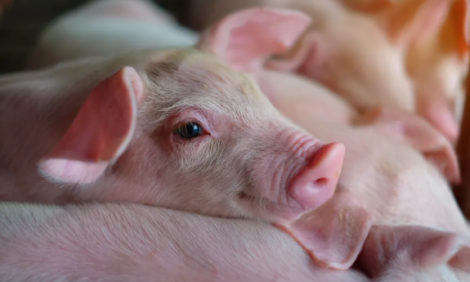



Validating the Odor Footprint Tool Using Field Data
By Richard R. Stowell, Kara R. Niemeir, Dennis D. Schulte¹. This study supports using the Odor Footprint Tool as a planning and screening tool for assessing odor impact from livestock facilities and estimating minimum separation distances to meet annoyance-free targets.Summary
Trained participants monitored odors around a 4,800-head finishing site in eastern Nebraska during 2005 and 2006. "Mobile odor assessors" monitored odors within the downwind odor plume and reported that odors at off-site locations (at least 200 feet away) were consequentially annoying in 20 out of 192 assessments. On-site odor levels were considered annoying in 33 of 39 instances. For the same off-site locations and times, modeling predicted 18 annoying events, resulting in a 90 per cent prediction rate (18 vs. 20) of annoyance frequency. Five residents regularly monitored for odors outside their residences and made 1,007 assessments.
On 42 occasions, or 4.2 per cent of the total, residents reported that annoying odor levels were present, equating to a 95.8 per cent odor annoyance-free status. Predicted odor annoyance-free frequencies using the Odor Footprint Tool ranged from 90 to 99 per cent for the five residences, given the locations of the residences and the livestock production facilities in the area.
Background
Rural residents are concerned about the potential impacts of nearby animal feeding operations on the local environment, having fears that air quality will be degraded and that they will have to frequently endure annoying odors.
The Odor Footprint Tool is a science-based setback-estimation tool that has been developed at the University of Nebraska. It uses historical weather information and research on odor emissions and dispersion to determine minimum separation distances in differing directions from a site. The Odor Footprint Tool can help people visualize the projected impact of odors on the area surrounding a livestock facility and the reduction in odor impact achievable by implementing a proven odor control technology.
The primary objective of this project was to evaluate the Odor Footprint Tool’s performance within a rural setting. Ground-truthing the tool with a pork production operation, neighboring residents, and impartial outside participants in an odor monitoring study should encourage acceptance and subsequent adoption of the tool.
Methodology
For the odor-monitoring study, 16 people were trained to assess odors using state-of-the-art field methods.
Participants were trained to assess odor intensity, concentration, offensiveness, and character. Participants also provided a rating of the odor’s "annoyance potential" by specifying whether the odor was "not annoying" or either "slightly," "moderately," "highly" or "extremely annoying."
This subjective rating was to encompass how the state of odor would affect their behavior (i.e. any change in activity) and how long the event would be remembered (e.g. hours vs. months).
This information was collected to help qualify prediction of odor annoyance and to obtain a more direct linkage between odor levels and likely consequences of odor events.
Moderately, highly, and extremely annoying states of odor were collectively referred to as "consequentially annoying," since a behavioral response was involved.
Participants monitored odors around a 4,800-head finishing site in eastern Nebraska during 2005 and 2006. For six consecutive Tuesday evenings during the summer of 2005, five to seven participants from Lincoln traveled to the area to monitor odor levels at locations downwind of the selected site, both before and after dark. During late spring and summer of 2006, two participants from another rural community in the local county monitored odor levels at downwind locations two to five times a week.
Both of these groups were referred to as "mobile odor assessors."
During that same time period, seven people, who owned residences within 1.5 miles of the selected site also monitored odors.
Five of these individuals monitored for odors three times a day — once each during daylight, twilight and nighttime conditions – just outside their residence.
Dispersion modeling was then performed for the times and locations corresponding to the field odor assessments to compare model predictions with field observations. Additional sources of livestock odor were limited mainly to two other swine facilities that were at least ¾ of a mile away.
Odor sources were determined based upon wind direction, assuming no background odor.
Results and Discussion
Based upon data reported by the mobile odor assessors, the state of odor at off-site locations (at least 200 feet away) was reported to be consequentially annoying in 20 out of 192 in-plume assessments. On-site odor levels (within 100 feet of the facility) were quite likely to be considered annoying (33 of 39 instances). When on-site data was included, the rate rose to 53 consequentially annoying ratings out of 231 total in-plume assessments.
Modeling of each these assessment periods predicted 18 annoying odor events at the corresponding off-site locations. The 90 per cent prediction rate (18 predicted vs. 20 reported) for annoyance frequency was considered very promising given the nature of what is involved (odor, weather phenomena, and human assessments). Some steps for fine tuning the predictive capabilities are being investigated to address the slight under-prediction of annoying odor levels and to minimize error rates.
Five residents regularly monitored for odors outside their residences and made a total of 1,007 assessments. This large number of observations covering a broad spectrum of weather conditions was desired to test the general accuracy of the Odor Footprint Tool's prediction of "odor annoyance-free frequency." "Swine-related odor" was detected during 92 of the observations or 9.1 per cent of the total, with a range of 0-14.0 per cent among residents. On 42 of these odor events, or 4.2 per cent of the total assessments, residents indicated that the states of odor were annoying. Since annoyance typically was not qualified as to whether it was "consequential" or not, the annoyance potential numbers for the residents indicate any degree of perceived annoyance. An annoyance frequency of 4.2 per cent equates to a 95.8 per cent odor annoyance-free status overall. Given the locations of the residences with respect to the three swine production facilities in the area, predicted individual odor annoyance-free frequencies using the Odor Footprint Tool ranged from 90 to 99 per cent.
Annoyance frequencies for individual residents ranged from 0 to 11.4 per cent and showed considerable variation due to individual biases (some residents were for and some against having the swine facilities in the area), senses of smell, data collection times, etc. On the whole, though, the composite annoyance-free frequency based upon information supplied by area residents was comfortably within the predicted range.
Evening measurement times were selected for the mobile odor assessors to increase likelihood of having stable atmospheric conditions. When unstable conditions existed, it was much more challenging to locate the odor plume as odors were quickly dispersed and diluted at off-site locations to levels not normally considered to be consequential.
During relatively calm or otherwise stable atmospheric conditions, though, exhausted odorous air stayed near the ground, and odor concentrations diminished much more slowly. Under these stable conditions, odor was detected a mile or more downwind. The residents, on the other hand, were asked to make numerous measurements at differing times of day to better represent prevailing atmospheric conditions and limit selective timing of measurements.
Summary and Conclusions
A field odor monitoring study was conducted to help validate use of the Odor Footprint Tool for assessing odor impact in rural communities and estimating minimum separation distances needed to maintain odor annoyance-free criteria. The study employed and trained local residents as well as mobile odor assessors from outside the area to document odor conditions in the vicinity of a 4,800-head swine finishing facility.
The two main results of this study were that:
- The dispersion model’s prediction rate for the frequency of consequential annoyance was 90 per cent, when compared to observations made by trained mobile odor assessors at off-site locations; and
- The overall frequency of annoying states of odor, as documented by area residents, was 4.2 per cent, which corresponded well with the predicted range (90 to 99 per cent odor annoyance-free) for the residences using the Odor Footprint Tool.
Predicted frequencies of odor annoyance compared favorably with actual observations, so the conclusion was made that there is good support for using the Odor Footprint Tool as a planning and screening tool, especially with animal housing facilities.
Implications
The data from this field study confirm our understanding that, most of the time, odors are quickly dispersed and diluted to off-site levels that would not normally be considered consequential. Producers need to recognize, though, that when stable atmospheric conditions keep odorous air near the ground, odor concentrations diminish much more slowly, and the potential for negative, consequential odor effects extends greater distances downwind. The composite annoyance-free frequency based upon information supplied by area residents was comfortably within the predicted range using the Odor Footprint Tool.
The predicted frequency of consequential odor events also matched up reasonably well with information provided by trained mobile odor assessors.
The information from this study supports using the Odor Footprint Tool as a planning and screening tool for assessing odor impact from livestock facilities and estimating minimum separation distances to meet annoyance-free targets.
Note
¹Richard R. Stowell is an extension specialist in animal environment; Kara R. Niemeir is graduate research assistant and Dennis D. Schulte is a professor in the Department of Biological Systems Engineering.
Acknowledgements
This study was supported by a grant from the Nebraska Pork Producers Association.
Further Reading
| - | You can view the full report by clicking here. |
| Go to other articles from the Nebraska Swine Report 2008 by clicking here. |
March 2008








